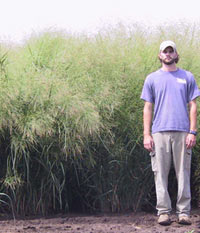A long-standing mission of the DOE has been to develop alternative sources of energy from biomass and among the targets is Switchgrass (the genome of which can be accessed at JGI’s Plant Portal, Phytozome): http://bit.ly/JGI-Switchgrass. This native grass has many traits that make it well suited for use as an energy feedstock. Yields of switchgrass are high, averaging 7 tons per acre in unirrigated field trials with some lines yielding up to 10 tons per acre. Production costs are low because of the plant’s low nutrient use, minimal pesticide requirements, propagation by seed, and perennial growth habit. Switchgrass can be harvested with conventional haying equipment, and its wide adaptability allows it to be grown productively across a large geographic area, including marginal regions that would otherwise be unproductive. Associated environmental benefits of switchgrass cultivation derive from its large root mass, which increases soil organic matter, prevents soil erosion, and acts as a carbon sink, further sequestering greenhouse gases. It is currently planted on much of the 32 million acres of land that has been enrolled in the USDA Conservation Reserve Program, and continuing work within the USDA, DOE, and scientific community is focusing on production methods, cultivar improvement, and feedstock quality.
 Through the generation of a large number of expressed sequence tags (ESTs), this sequencing effort will likely identify most genes in switchgrass and also will uncover a large segment of the molecular diversity in this species. This diversity is likely to include allelic variation in genes contributing to biomass production and other traits relating to its properties as a feedstock. As an undomesticated species in a relatively low-input production system, the most practical approach to improving biomass yield potential in switchgrass is through release of improved cultivars. Exploitation of this large data set will hasten development of DNA marker-based molecular breeding approaches that will speed the process of cultivar development by allowing artificial selection at the seedling stage. The EST data will also enable basic genetic and physiological studies focused on feedstock improvement by providing an inventory of genes that can be studied.
Through the generation of a large number of expressed sequence tags (ESTs), this sequencing effort will likely identify most genes in switchgrass and also will uncover a large segment of the molecular diversity in this species. This diversity is likely to include allelic variation in genes contributing to biomass production and other traits relating to its properties as a feedstock. As an undomesticated species in a relatively low-input production system, the most practical approach to improving biomass yield potential in switchgrass is through release of improved cultivars. Exploitation of this large data set will hasten development of DNA marker-based molecular breeding approaches that will speed the process of cultivar development by allowing artificial selection at the seedling stage. The EST data will also enable basic genetic and physiological studies focused on feedstock improvement by providing an inventory of genes that can be studied.
Principal Investigators: Christian M. Tobias and Gautam Sarath (USDA-ARS).
JGI Switchgrass Community Partners: